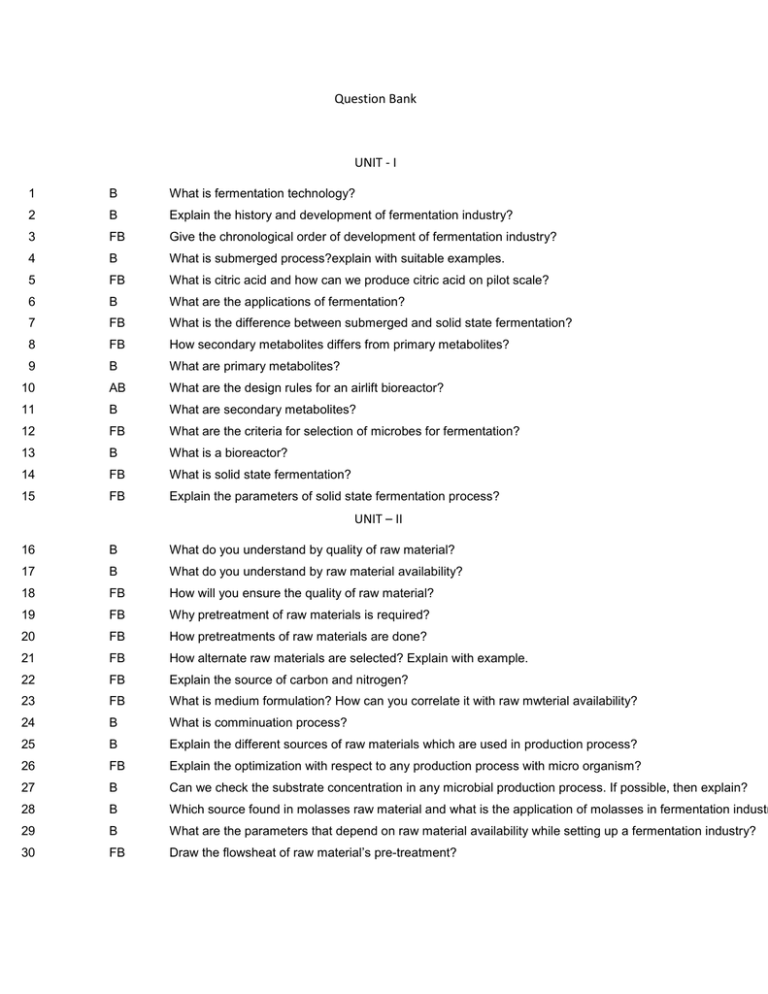File
advertisement

Question Bank UNIT - I 1 B What is fermentation technology? 2 B Explain the history and development of fermentation industry? 3 FB Give the chronological order of development of fermentation industry? 4 B What is submerged process?explain with suitable examples. 5 FB What is citric acid and how can we produce citric acid on pilot scale? 6 B What are the applications of fermentation? 7 FB What is the difference between submerged and solid state fermentation? 8 FB How secondary metabolites differs from primary metabolites? 9 B What are primary metabolites? 10 AB What are the design rules for an airlift bioreactor? 11 B What are secondary metabolites? 12 FB What are the criteria for selection of microbes for fermentation? 13 B What is a bioreactor? 14 FB What is solid state fermentation? 15 FB Explain the parameters of solid state fermentation process? UNIT – II 16 B What do you understand by quality of raw material? 17 B What do you understand by raw material availability? 18 FB How will you ensure the quality of raw material? 19 FB Why pretreatment of raw materials is required? 20 FB How pretreatments of raw materials are done? 21 FB How alternate raw materials are selected? Explain with example. 22 FB Explain the source of carbon and nitrogen? 23 FB What is medium formulation? How can you correlate it with raw mwterial availability? 24 B What is comminuation process? 25 B Explain the different sources of raw materials which are used in production process? 26 FB Explain the optimization with respect to any production process with micro organism? 27 B Can we check the substrate concentration in any microbial production process. If possible, then explain? 28 B Which source found in molasses raw material and what is the application of molasses in fermentation industr 29 B What are the parameters that depend on raw material availability while setting up a fermentation industry? 30 FB Draw the flowsheat of raw material’s pre-treatment? UNIT – III 31 B What is metabolism. Discuss catabolic and anabolic processes in detail. 32 FB Differentiate between catabolic and anabolic processes? 33 FB What is induction? 34 FB What is nutritional rerpression? 35 AB What do you understand by carbon-catabolite repression? Explain the process? 36 B What is crabtree effect? 37 AB What is feedback inhibition? How it differ with feedback repression? 38 FB What is feedback repression? Explain an example? 39 AB What are the regulatory and structural genes involved in lactose operon and their role? 40 AB What is the importance of mutants in fermentation industry? Explain with examples? 41 FB What is the importance of regulating the catabolic process in microorganisms. 42 FB Discuss the strain improvement process for secondary metabolite culture? 43 AB Differentiate between spontaneous and induced mutations? How chemical mutagenesis can be used for s 44 AB What is the importance of catabolic process in cell mass produvction? 45 FB In metabolism process, which process is known as endergonic reaction? UNIT – IV 46 B What do you understand by overeproduction of metabolites 47 FB Enumerate the criteria for media development to grow a desired mutant of industrial fermentation? 48 FB Explain the procedure of overproduction of secondary metabolites with an example? 49 B Explain different types of mutants? 50 AB What is enrichment culture? Discuss the screening methods of industrially important strain? 51 FB What are the procedures for isolation of mutants? 52 FB Discuss the methods of preservation of mutants? 53 FB Discuss the procedure of mutant development of a desired microbe with stable capacity of producing desir 54 B What is continuous process? 55 FB What is the differences between batch and continuous fermentations? 56 B Discuss the general component of fermentation media? 57 AB What are the various additives used in ethanol fermenting molasses, as substrates? Explain in detail? 58 B Enumerate four microbial processes which are exploited on industrial scale? 59 AB Discuss the overproduction of metabolites in a computer controleed fermnetation vessel? 60 AB What are the quality control steps that must be followed during alcohol production? UNIT – V 61 B What is recombinant technology? 62 FB How is recombinant technology useful with respect to fermetation process? 63 FB Discuss the laboratory scale, pilot scale and industrial sclae fermentation processes? 64 FB What are the current strategies of production of genetically enbgineered metabolites?what is their importan 65 FB What is recombinat protein? Does nature of recombinant protein different from normal protein? 66 FB What is a cloning vector? Why is it necessory in fermentation technology? 67 AB Enumerate the stability issues of genetically engineered microbes in an fermentation vessel? 68 AB Describe the flow diagram for recombinant protein production plant from laboratory to final packaging stag 69 AB Describe the steps involved in large scale recombinant insulin production? 70 AB How much steps are used in genetically engineered production of Lysine?discuss? 71 AB Explain the upscaling process strategy for the production of a recombinant microbial product? 72 FB What is site-directed mutagenesis? 73 FB What are the essential requirements for large scale production of genetically engineered metabolites? 74 FB What is plasmid?explain the role of plasmid in fermentation technology? 75 FB What is the difference between plasmid and vector?





